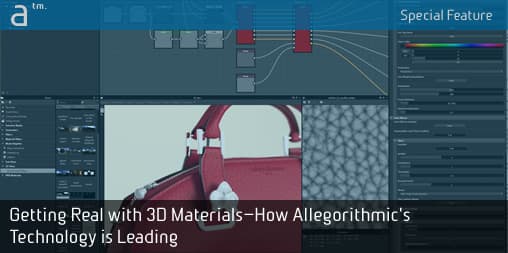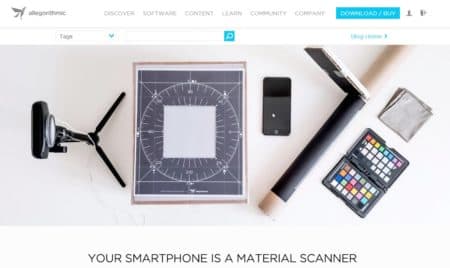Just before this month’s big SIGGRAPH 2017 confab, I had a chance to talk to Pierre Maheut, Product Manager for Architecture and Industrial Design at Allegorithmic. If you have not heard of this software company before you are not alone. The France-based software firm feels very new on the scene even though the company was established more than 14 years ago.
Just some background. Allegorithmic grew out of national award-winning Ph.D. research by Dr. Sébastien Deguy. He teamed with Cyrille Damez who would later become the CTO of Allegorithmic. The main office is in Clermont-Ferrand, France, with secondary offices in Paris, Lyon, and smaller but key offices abroad in the US, Canada, China, and Korea.
Fast Moving and Growing Into Architecture
In his opening remarks to me, Pierre Maheut notes that today Allegorithmic is a world leader in 3D texturing for the video game market. “We have more than 95 percent of the AAA studios; the AAA studios are the largest game studios that are developing blockbuster computer games,” he says.
But while there is hardly a game coming from today’s largest video game studios that do not touch Substance, the real excitement ahead of SIGGRAPH 2017—and part of the reason the company is talking to Architosh—is because Allegorithmic is making big moves in the world of Architecture and Industrial Design.

01 – Allegorithmic’s Substance product line includes Substance Painter, Substance Designer, Substance B2M and other tools. The tools allow sophisticated industry-leading creation of both scanned and procedural textures for use in visualization programs.
“Beginning at the start of last year (2016) we started focusing on VFX and animation,” says Pierre, “but even running back about three years ago, we have kept on getting more requests for us to address the architectural visualization market. And that is why we are here, to address these new markets by providing them the latest technology from the video game world.”
MORE: SIGGRAPH 2017—The Year of the Game Engine & Low-Level Graphics API
Technologies from the video game world are coming at most of the other 3D markets yet to be infiltrated by them. That is an emerging theme clearly strong within the world of product design and architecture.
Allegorithmic’s Substance Line and Technologies
Allegorithmic’s product line consists of Substance Painter, Substance Designer, Substance B2M and some other smaller tools. With over 120 thousand daily active users the company is growing rapidly. “We are about 90 plus employees now, but we were about 45 employees a year ago,” says Pierre.
And its A-list clients are not just the world’s biggest gaming studios. In the field of architecture, the company has won the hearts and minds over at Gensler, one of the world’s largest and most innovative architecture firms. In fact, at SIGGRAPH Gensler made a presentation about the use of Substance in their visualization workflows.
MORE: Why Gensler Architects Have Embraced Allegorithmic’s Substance Software
The Substance product line has become an industry standard for the PBR material authoring workflows that go into today’s computer games but also increasingly visualization for other industries. PBR stands for “physically-based rendering, ” but the term PBR shader or PBR material roughly refer to the same thing—a method referring to 3D texturing or materials that use realistic lighting based on measured surface values to accurately represent the real world. (see image 01 – 02).

02 – Allegorithmic’s Substance product line includes Designer which is aimed at the creation of PRB textures for use in 3D rendering, game development, and other visualization programs.
When 3D renderers produce images from models applied with Substance-based procedural textures images just look amazingly real. (see image 03 below). The node-based Substance Designer is the creative, technical app where technical 3D artists work with and create amazing procedural textures. (see image 02).
“What we want is to make the texturing process a process where artists can really express themselves,” says Pierre.
Getting Things Hyper Real
While Substance Designer is the main tool to create procedural textures, via the node graph interface, Substance Painter is the tool where you apply these textures (materials) to 3D models and further work on them.
“Substance Painter is, from a pure market point of view, our flagship product,” adds Pierre, “it is very close to Photoshop and easy to handle. You can paint on the surfaces in 2D or 3D; it is up to you. And what is most important is that when you paint a material, you paint all the channels together.”
Substance Painter is how you can make an architectural environment insanely real looking. You can accomplish this by what do to objects in the environment or the structure of the environment itself. Pierre showed me an image with beautiful chairs that had scratches in their paint job. And then there is the leather hand bag that you swear just has to be a photo of a real physical product. I marvel at the stitching. (see image 03 below). “The stitching is in the texture in that model,” says Pierre.
The Architecture Industry—Wants and Needs
Allegorithmic is in high gear at the moment determining what is next for the visualization of the architectural market. The goals are similar to the product design world but have more layers in the architectural market, which is naturally more complex.

03 – This leather bag isn’t real, but its stitching and quality of finish on all its surfaces certainly make this all 3D image completely fool the human eye.
“Scanning materials is a big thing for us,” adds Pierre. “We recognize that architects want to work with the real materials they want to use on their projects. But scanning is complex.” At the moment in the AEC visualization industry, the big thrust of new technology is in the area of interactive-rendering with tools like Lumion and Twinmotion. Also, game engines are penetrating these tools and market because game engines provide the physics engines that make environments come to life as well as are avenues for VR/AR distribution.
“You can always export the materials out of Substance and bring them into tools like Lumion,” says Pierre, “but very recently Twinmotion moved to the Unreal Engine that supports our technologies. They are going in the right direction as they are supporting game technologies.”
Back to the issue of scanning, Allegorithmic has another tool called Substance B2M, which is an image to material-generator. While not as powerful and with a different orientation than Substance Designer, B2M can take in images of materials from even your smartphone and turn them into textures for your 3D models.
Allegorithmic also has detailed instructions on its website to show its users how to build material scanners using smartphones or even better DSLRs. “We have already created nodes to extract things like the bump and normal maps,” adds Pierre.
Closing Comments
While the visualization market in architecture continues to expand Pierre said he recognizes that there is pressure on the AEC professional to produce work quickly. The company has a new service called Substance Source which started with 600 high-quality materials provided by Allegorithmic and within those materials are 200 set up just for AEC visualization. At the time of this writing, those materials have expanded to over 1,000. The goal is simple: provide great materials that architects can use in their projects immediately.
“The user can download materials from Substance Source as well as the actual node-graph files to work with in Substance Designer,” adds Pierre. “This means you can reuse part of the graph, or just learn from it, to make your own procedural textures.”





Reader Comments
Comments for this story are closed